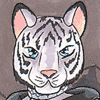
As mentioned in the other parts of this series, this Paw Study is part of the Balaa’s “Artist Conspiracy” series, who’s whole purpose is to provide both good reference pictures for artists as well as inspiration to try them out in new artwork! There are nine pictures in this series, with the “number zero” having been posted a long, long time ago now: http://www.furaffinity.net/view/432365/
As this /is/ a Paw Study, I thought the very best candidate for modeling would best be a kitty with very large and imposing paws, who doesn’t mind showing them off. So, logically, that led me to The DrifterMan, who was more than happy to volunteer.
This picture is somewhat of a follow-up to the previous picture, number 4 of 9. This one is zoomed out a bit, which is humorous from the perspective of seeing Drifter doing a bit of that stretchy cat thing, as well as seeing his left forepaw flexed but his right forepaw relaxed.
As I mentioned in the previous description, looking at the left forepaw you can see the structural mechanics of Drifter’s paw. From the casual observation is sometimes easy to forget that paws do indeed have individual digits. I think this photo clearly demonstrates the presence of these digits. While the last photograph and this one clearly display the joint structure of the paw, the cause of the position and slight curling of the right forepaw, is also easy to see the individual digits of the right paw as well even without the claws being extended. No little more difficult to see, one can still observe the darker fur behind which the claws are hiding.
For other cougar trivia, it can be seen the thick, long, almost white, underside fur on drifter’s chest and muzzle and chin, but contrasting to many other cougars, the very dark nose. It can also be conceived in this photo, that cougars have very dark fur on the back sides of their years. Contrary to some perceptions, cougars do not have ocelli - “the eye spot” - on the back of the ears like many of the other cats do, such as tigers, leopards, and even bobcats.
So this is the fifth image of the Drifter Paw Study. Enjoy!
This picture was taken 26-Jul-03. The image was taken with a Canon EOS 10D and the EF 28-200mm f/3.5-5.6 USM lens. The original was taken at full frame of 3072x2048x24b, ISO eqv 400, 1/125 shutter, f/4. This image was shrunken down for space conservation.
As this /is/ a Paw Study, I thought the very best candidate for modeling would best be a kitty with very large and imposing paws, who doesn’t mind showing them off. So, logically, that led me to The DrifterMan, who was more than happy to volunteer.
This picture is somewhat of a follow-up to the previous picture, number 4 of 9. This one is zoomed out a bit, which is humorous from the perspective of seeing Drifter doing a bit of that stretchy cat thing, as well as seeing his left forepaw flexed but his right forepaw relaxed.
As I mentioned in the previous description, looking at the left forepaw you can see the structural mechanics of Drifter’s paw. From the casual observation is sometimes easy to forget that paws do indeed have individual digits. I think this photo clearly demonstrates the presence of these digits. While the last photograph and this one clearly display the joint structure of the paw, the cause of the position and slight curling of the right forepaw, is also easy to see the individual digits of the right paw as well even without the claws being extended. No little more difficult to see, one can still observe the darker fur behind which the claws are hiding.
For other cougar trivia, it can be seen the thick, long, almost white, underside fur on drifter’s chest and muzzle and chin, but contrasting to many other cougars, the very dark nose. It can also be conceived in this photo, that cougars have very dark fur on the back sides of their years. Contrary to some perceptions, cougars do not have ocelli - “the eye spot” - on the back of the ears like many of the other cats do, such as tigers, leopards, and even bobcats.
So this is the fifth image of the Drifter Paw Study. Enjoy!
This picture was taken 26-Jul-03. The image was taken with a Canon EOS 10D and the EF 28-200mm f/3.5-5.6 USM lens. The original was taken at full frame of 3072x2048x24b, ISO eqv 400, 1/125 shutter, f/4. This image was shrunken down for space conservation.
Category Photography / Animal related (non-anthro)
Species Housecat
Size 1280 x 854px
File Size 191.4 kB
(belatedly) From the physiology perspective, most animals paws are much like our own digits in "design", short of the bones themselves are shorter, and for animals with claws (retractile or otherwise), have effective one less joint, as that last joint of the "finger" is dedicated to holding the claw. Nonetheless, from a purely engineering perspective, the paw is still a marvel to behold! :)

 FA+
FA+











Comments